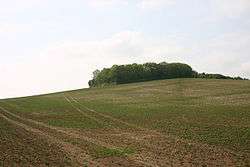Battle of Assandun
The Battle of Assandun (or Essendune)[1] was fought between Danish and English armies on 18 October 1016. There is disagreement whether Assandun may be Ashdon near Saffron Walden in north Essex or, as long supposed, Ashingdon near Rochford in southeast Essex, England. It ended in victory for the Danes, led by Canute the Great, who triumphed over the English army led by King Edmund Ironside. The battle was the conclusion to the Danish reconquest of England.
| Battle of Assandun | |||||||
|---|---|---|---|---|---|---|---|
| |||||||
| Belligerents | |||||||
| Kingdom of England | Cnut the Great's soldiers | ||||||
| Commanders and leaders | |||||||
| Edmund Ironside | Cnut the Great | ||||||

Battle
During the battle, Eadric Streona, the Ealderman of Mercia, left the battle allowing the Scandinavians to break through the English lines and win a decisive victory. Eadric Streona had previously defected to Cnut when he landed in England but after Cnut's defeat at the Battle of Otford he came back to the English, but this was a trick as he would betray them at Assandun.
The battle is mentioned briefly in Knýtlinga saga which quotes a verse of skaldic poetry by Óttarr svarti, one of Canute's court poets.
King Knut fought the third battle, a major one, against the sons of Æthelred at a place called Ashington, north of the Danes' Woods. In the words of Ottar:
- At Ashington, you worked well
- in the shield-war, warrior-king;
- brown was the flesh of bodies
- served to the blood-bird:
- in the slaughter, you won,
- sire, with your sword
- enough of a name there,
- north of the Danes' Woods.[2]
During the course of the battle, Eadnoth the Younger, Bishop of Dorchester, was killed by Cnut's men whilst in the act of saying mass on behalf of Edmund Ironside's men. According to Liber Eliensis, Eadnoth's hand was first cut off for a ring, and then his body cut to pieces.[3] The Ealdorman Ulfcytel Snillingr also died in the battle.
Aftermath
Following his defeat, Edmund was forced to sign a treaty with Canute. By this treaty, all of England except Wessex would be controlled by Canute and when one of the kings should die the other would take all of England, that king's son being the heir to the throne. After Edmund's death on 30 November, Canute built a church, chapel, or holy site after winning the battle to commemorate the soldiers who died in battle. A few years later in 1020 the completion of the memorial church known as Ashingdon Minster took place, on the hill next to the presumed site of the battle in Ashingdon. The church still stands to this day. Canute attended the dedication of Ashingdon Minster with his bishops and appointed his personal priest, Stigand, to be priest there. The church is now dedicated to Saint Andrew but is believed previously to have been dedicated to Saint Michael, who was considered a military saint: churches dedicated to him are frequently located on a hill.
Battlefield location
There is another possible location of the battle; Ashdon, also in Essex. There have been many finds of Roman and Anglo-Saxon coins in the area. Historians have argued inconclusively over the two sites for years. Also, the 10th-century wooden village church, itself possibly built on the site of a pre-Christian temple, was probably rebuilt in stone in the early 11th century, about the right time for Canute's conquest. Unfortunately little remains of the earlier structures, which were largely obliterated by the construction of the current church of All Saints during the late 13th to early 15th centuries.[4]
References
- Smith, Ernest F. Fairbairn, W. H. (ed.). Tewkesbury Abbey. Notes on Famous Churches and Abbeys. [1916]. London: SPCK. p. 2.CS1 maint: ref=harv (link)
- "Knut's Invasion of England in 1015-16, according to the Knytlinga Saga". De Re Militari. Archived from the original on 26 September 2011. Retrieved 17 October 2011.
- Fairweather, Janet, trans., Liber Eliensis (Woodbridge, 2005), p. 169
- "All Saints Church, Ashdon, Essex - History". Archived from the original on 6 October 2014. Retrieved 10 May 2013.
- Benton, Philip (1867). The History of Rochford Hundred. A. Harrington.